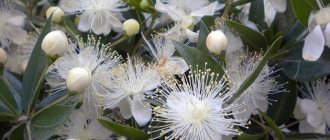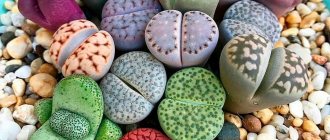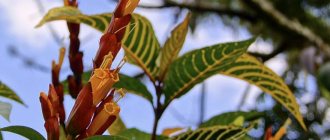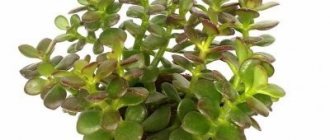Do you think it’s impossible to grow a handful of coffee beans for a cup of coffee? It’s completely possible and not even difficult at all.
The coffee tree is very beautiful in any condition. When it blooms, its aroma will not leave anyone indifferent; when there are no flowers, the plant is decorated with green, glossy, wavy leaves.
How to choose the right seedling?
Where to begin? The most realistic thing is going to the store. You will be offered a great variety of copies. Take your time. Choosing and purchasing a coffee seedling is a responsible matter.
- Take a good look at the appearance of the plant:
- the color of the leaves should be bright green, without damage or spots;
- there should be a lot of leaves on the plant;
- absence of signs of diseases and insects.
- Read the variety label carefully:
- C. arabica is a true coffee tree and is grown as a houseplant;
- nana - smaller in size, but blooms more readily. More decorative.
- For transportation in the cold season or in windy weather, pack the seedling well so as not to damage it on the way home.
Caring for the plant after purchase
The coffee tree requires special care at home, but is little susceptible to disease. At home, do not place the plant directly next to your flowers. Give him a short quarantine and monitor his condition for a few days. Think carefully about where you will place your coffee permanently. This is not an idle question.
Coffee is mainly grown in the tropics. And we know that it is warm and humid there. Therefore, in the room where coffee grows, the temperature should be stable all year round, 18 - 20 degrees. There is no need to place the plant on the window if your winters are cold. This will lead to cooling of the earthen coma, and the plant may die.
Another reason why you should not place a coffee tree indoor plant on a windowsill is the size of the plant itself. Over time, it will grow and reach one and a half meters in height. The crown of the coffee plant is spreading. No window sill is suitable for such a plant.
Also, for good growth of your pet, you will need to constantly spray water. It is better if this is a place next to the eastern or western window.
Flowering and fruiting
If you organize proper care for the plant, it will thank you with flowers.
Coffee blooms with small flowers. The flowers smell very delicate, elegant aroma. Many coffee lovers, having smelled this aroma for the first time, purchase coffee seedlings thanks to the smell of the flowers.
The coffee tree at home blooms annually, sometimes it can bloom twice a year. In spring and autumn.
Why doesn't the coffee tree bloom at home?
The flowering of coffee depends on how the plant is grown. If from a seed, you will have to wait several years (4-5 years) for flowering; if your seedling grew from a cutting of an already mature plant, it may bloom the next year. If the coffee does not bloom in due time, look for errors in care.
Artificial pollination is not required. The ovary occurs on almost every flower. The ovary looks like a small green pea. As the fruit grows, it turns red and then turns dark burgundy. The fruits ripen for a very long time, within 9 months.
Transfer
How to transplant a coffee tree at home?
While the plant is small and gaining strength, it will have to be replanted almost every year in the spring. As they grow older and increase in volume, replanting can be done no more than once every three years , but annually change the top layer of soil to a more fertile one.
It is best to use ready-made soil mixture for replanting. If this is not possible, you can prepare it yourself. We take garden soil - 3 parts, humus - 1 part, peat - 1-2 parts, sand (preferably river) - 1 part. Experts advise adding a small amount of wood ash. Don't forget the drainage, which should be at least 1/5 of the pot.
Reproduction at home
How to propagate a coffee tree at home?
There are two types of propagation of the coffee tree at home.
- Seeds. This type of reproduction is considered very labor-intensive. Coffee seeds lose their viability very quickly and need to be planted as quickly as possible. The quality of the seeds and their germination cannot be checked before planting. Coffee seeds are in a very hard and tough shell that needs to be broken down. Seeds must be soaked in a growth stimulant.
Treated seeds are grown at high temperatures, in a container with loose soil, which is best covered with glass. In a couple of months the seed should germinate.
- Cuttings. This method is believed to be easier. Choose a healthy, non-flowering shoot. The prepared cuttings also need to be kept in a growth stimulator. It is better to root the cuttings in sand. You can make a small greenhouse. A seedling grown in this way will begin to bloom and bear fruit earlier.
Choosing soil for a plant
The description of the flower must indicate that it prefers acidic soil. The pH level of the medium should be in the range of 5–5.5. It is easiest to use a ready-made substrate. Blends intended for citrus fruits are ideal for the coffee tree.
You can create soil by combining:
- 1 part peat;
- 2 parts coarse sand;
- 2 parts leaf soil;
- 4 parts manure humus;
- 4 parts of turf.
Additionally, add some crushed sphagnum moss. You can check acidity using litmus paper. If the indicator is violated, the soil must be artificially acidified.
Rules of care
How to care for a coffee tree at home?
For some reason, it is believed that growing a coffee tree at home is very difficult. Most often this occurs due to ignorance of the basic rules for caring for this plant.
Caring for a coffee tree at home is not difficult if you remember the basic rules.
- Temperature. A fairly high and, if possible, constant temperature all year round is required. In winter, when the temperature outside reaches sub-zero levels, it is important to avoid cold drafts and try to avoid cooling the flower pot.
Do not place the plant near heating sources. If the floor on which the flower stands is cold, it is better to place the coffee tree on a stand or nightstand. In summer, overheating should not be allowed.
The coffee tree is very beautiful in any condition. In order for a flower to always be attractive, you need to take care of it. Wash and wipe the leaves, systematically loosen the soil. Keep the flower pot clean. Remove yellowed leaves in a timely manner and form a crown if necessary.
Feeding schedule
Caring for a coffee tree indoors necessarily involves fertilizing. Special complex fertilizers are suitable for this purpose. You can make a solution based on chicken droppings yourself.
Fertilizing is done regularly. In the warm season, this is done about twice a month. In winter, procedures are not carried out more than once every 30 days. When flowering, the tree can be additionally fed with fertilizer containing potassium.
If the foliage begins to fade, then it is permissible to wipe it with lemon juice. Make a solution: a liter of water and 2–3 tsp. citrus squeezes. It is useful to pour the remaining liquid into the soil. It is not recommended to do this procedure more than once a month.
The benefits and harms of coffee
Coffee is a wonderful, invigorating drink. It’s wonderful to wake up in the morning and feel its enchanting aroma.
What harm is there from coffee?
The debate about whether there is more benefit or harm in coffee has been going on ever since people learned about it. Some prove that coffee excites, increases muscle tone, stimulates physical activity, clarifies thoughts, and improves mood. And this list goes on and on.
Opponents of coffee claim that it increases blood pressure and cholesterol. However, it has been proven that if you pass the brewed drink through a paper filter or napkin, coffee becomes safe. A paper filter removes kahweol and cafestol from the drink, substances that increase cholesterol levels in the blood. Whether coffee is harmful or healthy is up to everyone to decide for themselves.
As for the coffee tree in your home, we can safely say that it will only benefit you.
What are the benefits of coffee?
The plant cleanses the air well and saturates it with oxygen. Its beautiful appearance lifts your spirits, and by inhaling the aroma of flowers you can practice aromatherapy.
Diseases and pests
The indoor coffee tree is not susceptible to disease and can only get sick if you bring home an infected plant or use contaminated soil.
If your pet's leaves begin to dry out, figure out whether it is a disease or an error in care.
Perhaps the soil has dried out or, on the contrary, you are watering your plant too often.
As for pests , when it’s dry, spider mites appear; scale insects, mealybugs, and whiteflies can appear from other plants. In this case, please be patient and use special medications.
To ensure that your plant pleases you for as long as possible, remember that prevention is better than cure . You can also add it faster and cheaper. Inspect your coffee regularly and take decisive action at the first symptoms of disease or pest infestation.
Are you still in doubt? Do not be afraid. You will succeed. Grow a coffee tree, wait for it to bloom, brew a cup of coffee from the collected fruits, and give others advice on caring for and growing a coffee tree at home.
If you find an error, please select a piece of text and press Ctrl+Enter.
The coffee tree (Coffea) is a tree-like evergreen plant of the madder family, producing bright burgundy-colored fruits with seeds-grains .
This is a rather tall shrub, reaching a length of 8-10 meters in natural conditions, with large, leathery, opposite leaves and white or cream-colored inflorescences. In cultivation, the tree is pruned to a height of 1.5-2.5 meters to facilitate maintenance and harvesting. The homeland of the coffee tree is the tropics of Ethiopia. This species has an average development intensity with an increase of 5 to 10 cm per year. This is a perennial crop whose life expectancy depends on favorable climatic conditions. There are known specimens that continue to bear fruit even at a hundred years of age.
If you like to grow fruit plants at home, then watch how to grow a homemade banana.
| It has an average intensity of development with an increase of 5 to 10 cm per year. |
| Blooms from April to October. Next, edible fruits appear. Only an adult plant blooms and bears fruit - 3-4 years. |
| The plant is easy to grow. |
| Perennial. |
How to form a crown
The coffee tree itself is highly decorative. Its shoots are weakly branched, and large beautiful leaves form a beautiful crown. In general, coffee does not require decorative pruning.
However, it all depends on the specific instance. It is necessary to regularly trim dried shoots, and it is also a good idea to remove too long branches. The fact is that they will take away the energy that the plant needs to bloom. It is better to carry out the operation in late winter - early spring.
If you doubt whether your green pet needs pruning, then it is better not to do it.
Caring for a coffee tree at home. Briefly
Contrary to the opinion that culture is capricious, a coffee tree grows at home without any problems if you follow the main principles of care:
| Temperature | In spring and summer – 20-30ºC, in winter – 12-15ºC. |
| Air humidity | Above average – about 70%. |
| Lighting | Indirect solar or supplemental illumination; north, west windows. |
| Watering | With softened, settled water at least once every 2 days in summer, in winter - as the top layer of soil dries out. |
| Priming | Slightly acidic soil with a full drainage layer. |
| Feeding and fertilizer | Apply organic matter every two weeks, and mineral fertilizer 2 times a month. |
| Transfer | This is done when the pot becomes too crowded, about once every three years. |
| Reproduction | It is carried out vegetatively or by sprouting from seeds. |
| Features of cultivation | You should protect your coffee from even the slightest draft, and also avoid excessive watering. In winter, a period of rest away from heating devices is required. |
Coffee transplant
When the root system completely fills the flowerpot, it’s time to replant the plant. Staying in one pot for a long time inhibits its growth and impairs flowering and fruiting. The coffee tree is replanted annually until it reaches 3 years of age, and after that every 3-5 years.
The pot for replanting should be approximately 5 cm larger than the previous container. Transplantation can be carried out both after the berry harvest and before the flowering phase begins. The plant is transplanted together with a lump of earth.
How to replant a coffee tree at home:
- clean the roots of the tree from rotten and dry shoots;
- add a layer of drainage to the bottom of the pot - broken apricot kernels, nut shells, clay shards or expanded clay;
- add 2 cm of coarse river sand and nutrient substrate on top;
- lower the root of the plant with a lump of earth into the flowerpot so that the root collar is raised 1 cm above the ground level.
Water the transplanted coffee tree with warm, settled or melted water. After 2-4 days, the top layer of the soil mixture can be slightly loosened to maintain moisture balance and better oxygen supply.
Caring for a coffee tree at home. Details
Bloom
The active period of coffee development and flowering falls at the beginning of April and lasts until October .
Coffee is characterized by small inflorescences of white flowers, 4-6 pieces each, growing from the axils of the leaves and having a light aroma reminiscent of jasmine. The homemade coffee tree will not bloom right away.
As a rule, with proper maintenance and mandatory dry wintering, flowers can be expected within 3-4 years of the plant’s life.
Temperature
The optimal temperature for the growth and development of coffee at home is 23 degrees. But even in hotter conditions with sufficient humidity in the room, the tree will feel great.
In winter, he is provided with rest at low temperatures: 12-15 degrees Celsius.
Spraying
Daily spraying with soft, settled water is required for the coffee plant during dry summer periods. Once a month, for this purpose, you can use an infused ash solution, which has a preventive and protective function against pests and diseases. During cold seasons, coffee should not be sprayed if it is kept away from heating appliances.
Lighting
The coffee tree at home is not photophilous , therefore it does not need direct sunlight and grows well on western and northern windows or near them. Additional lighting will be required if the tree does not bloom for a long time and is always in the shade.
Watering a coffee tree
Despite the fact that this crop is essentially a tropical exotic, it does not like severe waterlogging and moisture in the pan.
At the same time, the soil should not be allowed to dry out. As soon as the leaves of the plant droop, you must water it immediately, otherwise it will be extremely difficult to revive it .
In winter, watering is reduced to once a week, also after checking the soil moisture level.
Coffee tree pot
It is recommended to select a flower pot for replanting a tree according to its root system. You shouldn’t take containers many times larger than you had before. The volume of the pot that is larger than the earthen ball with the roots of the plant is only 2-4 cm is sufficient. Otherwise, the soil will turn sour very quickly and the roots will rot.
Priming
The coffee tree plant at home prefers clayey, slightly acidic soil rich in organic matter. In addition to store-bought universal substrates, you can use soil consisting of garden, humus, and peat soil mixed with river sand, one part of each. Don’t forget about a complete drainage layer, which will prevent excess moisture from stagnating in the pot. In addition, gardenia or azalea soil is a suitable substrate for planting a coffee tree.
Diseases and difficulties in growing
Proper care at home usually does not lead to tree disease. The only thing is that greens can be attacked by spider mites. The fight against it is carried out using special drugs. Operate according to instructions.
Other painful conditions are usually associated with improper care. Each condition should be considered separately, its causes should be understood, and the conditions should be adjusted accordingly.
Looking at the photo of a coffee tree, it becomes clear how impressive this plant is. It will be an excellent addition to any interior. In this case, this option will not cause trouble when growing.
Coffee tree propagation
Growing a coffee tree from seeds
For the purpose of breeding coffee using seeds, only fresh, recently collected seeds are used. The older the grain, the less likely it is to sprout.
The sowing soil should be permeable and loose, for example, a mixture of leaf soil with river sand is suitable. Before sowing, it must be sterilized - held over steam from boiling water for about 10 minutes.
The seeds are laid flat on the surface of the soil without being buried; they rot in the ground. Then everything is watered with warm water and covered with polyethylene or a glass cap. Twice a week for 3 hours the greenhouse cap is removed to ventilate the soil. The most favorable germination temperature is 25 degrees. The first shoots can be expected no earlier than in 1.5-2 months. As soon as a few good leaves appear, the seedlings can be planted. Such a tree will bear fruit in 3-4 years.
Propagation of the coffee tree vegetatively
To breed coffee using this method, cuttings with two nodes are cut from last year's branches. They should first be soaked in a solution that stimulates growth, such as heteroauxin, for several hours. Prepared shoots are planted in a sand-peat mixture (1:1) with a depth of 3 cm. A drainage layer is required! Temperature conditions and watering are carried out in the same way as when growing seeds. For more successful rooting, it is recommended to organize bottom heating of the pot with cuttings.
After waiting for new leaves to appear from the bud, the sprouts can be planted. Coffee plants obtained in this way begin to bear fruit the very next year.
Diseases and pests
The main problems that gardeners face when growing a coffee tree:
- the edges of the leaves of the coffee tree darken and dry out due to lack of air humidity;
- the leaves of the coffee tree turn yellow when rot appears at the roots;
- brown spots on the leaves appear when there is a lack of nitrogen in the soil;
- holes form in the coffee tree leaf after sunburn;
- young leaves turn yellow, only green veins remain due to low acidity of the soil;
- leaves turn yellow, rot and fall off after excessive watering;
- In winter, the leaves of the coffee tree fall off when there is insufficient light;
- the coffee tree grows slowly if there is no regular feeding;
- leaves wrinkle and become covered with yellow spots when watered with hard water or lack of potassium;
- on the leaves of the coffee tree, purple or brown spots appear when there is a lack of phosphorus in the soil;
- young leaves are small and light yellow due to iron deficiency.
The most common pests found in coffee are scale insects, mealybugs and spider mites.
Popular variety of homemade coffee tree with photos and names
Arabian coffee tree
Everyone knows Arabica. Under natural conditions it reaches a height of 6 meters, but for home breeding its dwarf variety “Nana” with a maximum length of about 80 cm is used. It blooms twice a year and is easy to form.
Congolese coffee tree
Its second name is robusta. An unpretentious plant with a highly developed root system. The peculiarity of this type of coffee is the falling of fruit branches after natural death.
Liberian coffee tree
This is a large and very tall tree with a pyramidal crown, suitable for growing in greenhouses or large areas. The plant is resistant to most coffee tree diseases.
The coffee tree is a beautiful and unusual indoor plant that will not only perfectly decorate any interior, but with proper care will also produce fruits from which you can make a natural invigorating drink. In this article we will tell you how to grow a coffee tree at home and what recommendations you need to take into account, and the photos will help you get acquainted with this process more clearly.
Types of coffee trees
Arabian coffee tree
The species is very popular among gardeners and is a compact tree. The elongated ellipsoidal leaf blades have a dark olive bare front surface, and the back surface is painted in a paler shade. Small inflorescences collected in a bouquet reach about 20 mm in diameter. It was noted that the size of the inflorescence depends on the growing conditions. After the flower blooms, it begins to fade after just a few hours. However, the opening of the buds does not occur simultaneously, but gradually. When flowering ends, berry-shaped fruits are formed; after ripening, they acquire a burgundy hue. Once the flower is pollinated, a full 8 months pass before the fruit ripens. Paired fruits are similar in appearance to round beans. The height of such a plant is about 5 m.
Dwarf coffee tree Nana
The height of this compact tree is approximately 0.85 m. In indoor conditions, it blooms very luxuriantly and produces a good harvest. To give it the necessary shape, experienced gardeners resort to regular pinching of the tops of the stems and trimmings.
Liberian coffee tree
This species also grows well indoors. After ripening, its fruits acquire a sunny orange or scarlet hue. The length of the leaf plates reaches about 0.4 m. The height of the tree can be adjusted by cuttings, and with the help of them the crown is given the required shape. The inflorescences consist of light-colored flowers, in place of which large berry-like fruits then form.
Coffee tree: secrets of growing - Everything will be fine. Issue 665 from 09/07/15
Characteristics of a coffee tree
The birthplace of coffee is hot Africa, and specifically Ethiopia. All species known today came from there. But out of 50 varieties, only one is suitable for indoor decorative cultivation - it is called Arabian. Its main differences are its wavy, elongated, oval-shaped leaves with a rich green tint and a pointed tip. The flowers are white, formed in a tuft, then develop into greenish berries that turn reddish when ripe. From these fruits the grains are collected, which are then turned into a famous drink.
Where to put the plant
A young indoor coffee tree requires a lot of light, so it is best to place the pot on a windowsill in a warm room. Coffee also grows well on a north-facing window, but a south-facing window is best suited for it. One of the most important requirements is not to change the location of the plant and not to rotate the pot. This will cause foliage to fall, and the flowering tree may lose its buds and subsequently fail to bear fruit.
Placement nuances
The tropical origin of the plant does not mean that it must be placed in a south-facing window under the scorching sun. In excessively hot conditions, the tree runs the risk of not blooming. It is better to protect the plant from direct rays, but organize the lighting carefully.
If the location of the room faces north or west, then the flower is placed on the windowsill. In rooms facing south and east, the pot is removed from the window opening up to 1.5 m.
Be sure to remember that the coffee bush should not change its location. Turn the pot with the “pet” once every five years. To make the formation of the bush symmetrical, it is permissible to install a mirror next to the plant that will not reflect direct sunlight.
Suitable temperature, humidity and lighting for coffee
For normal development of a seedling, it requires the following air temperature:
- Summer period – up to +22 degrees;
- Winter period – up to +18 degrees.
In winter, the temperature in the home should not fall below +12 degrees, because if the temperature is lowered, the growth of the young green pet is inhibited and its roots rot. Not entirely comfortable conditions are quite suitable for an adult plant to overwinter. The acceptable temperature for it in the winter season is +10 degrees, it definitely needs good lighting and a little infrequent watering of the root zone.
The seedling loves it when its leaves are regularly sprayed with settled, warm water. This procedure is carried out at all times of the year. The home coffee tree should grow in moderately humid air. If it is dry or excessively wet, it inhibits the plant.
The growth of the seedling on the northern window will be long, flowering will be late, and fruiting will be delayed. Southern lighting also has its drawbacks. The leaves of the coffee tree can easily get sunburned, so in the summer season the plant is slightly shaded. To do this, attach a sheet of newspaper to the glass of the window with tape. The rays of the sun falling on the coffee, becoming scattered, do not burn the leaves.
If there is no good sunlight, then the adult “green resident” cannot form a full-fledged ovary. We must not miss the moment when the flower cluster forms fruit embryos; after this process, the plant must be shaded.
Rejuvenation
Unfortunately, about 10 years after planting, coffee begins to age. The decorative value of the plant decreases. The leaves become yellowish and limp. So, it's time to rejuvenate.
To do this, cut the stems. The procedure must be carried out with a sharp instrument so that the cuts are neat and even. Do not break the shoots under any circumstances! Even if the tree survives, it will finally lose its decorative effect and become ugly.
Don't forget to treat the cut areas with crushed activated carbon.
Soil, watering and fertilizing for the coffee tree
The most favorable soil for coffee is loose, breathable. When watering this soil, water well moisturizes the roots of the plant, does not stagnate, and its excess flows into the pan thanks to drainage.
- Combining leaf turf, worn peat and coarse river sand in proportions 1:2:2;
- Chernozem, sand, leaf turf and humus are mixed in equal proportions. Two parts of sour peat are mixed with them.
It is also advisable to finely chop and add sphagnum moss. It will ensure moisture retention in the soil and maintain its normal looseness and acidity. Don’t forget about good drainage at the bottom of the pot, otherwise stagnation of moisture can lead to the death of the roots.
A coffee tree needs to be replanted every spring up to three years old, and once every 2-3 years after it reaches four years old and beyond.
A coffee tree grown at home should be regularly watered abundantly in the summer, and in winter the water supply should be slightly reduced. It is best to “water” your coffee with soft rainwater.
To obtain additional moisture, the tree needs to be sprayed or wiped with a damp sponge. You can also sometimes give your “green friend” a warm shower or place the pot in a pan of water.
The following are used as fertilizers for feeding:
- Potassium, phosphorus and nitrogen mineral mixtures;
- Horn shavings;
- Mullein.
Planting a coffee tree from beans
To start growing a coffee tree with your own hands, you need to prepare a deep pot so that the tap root is comfortable and free. The grain must be lightly compressed with pliers or cut deeply with a knife so that the outer shell cracks. Then germination will begin faster. Otherwise, the grain will not be accepted until its outer shell has decayed.
The next procedure is as follows:
- The planting material prepared according to the above scheme is soaked overnight in a growth stimulator (for example, “Zircon”);
- To plant a tree of coffee beans, take a deep pot with good drainage, filled with slightly moist, loose soil mixture;
- We plant in the ground 3-4 cm with intervals between each grain of 3-5 cm;
- We water the soil, then cover the pot with a plastic bag or glass and place it in a warm room;
- Once every 14 days, open the pot, remove condensation and ventilate the crops. The first shoots “hatch” after 50-60 days.
It is better to choose fresh seeds. They are more likely to germinate. But from seeds that have been lying around for a long time, only 2-3 out of 100 can begin to grow.
Propagation of a coffee tree by cuttings
It is easier to propagate plants using green cuttings. To do this, you need to prepare a soil mixture of equal parts of acidic marsh crumbs based on peat and perlite. It will allow oxygen and moisture to pass through well. It is also necessary to disinfect the soil with a manganese solution.
- From an adult tree, select a twig with four leaves from the middle part of the crown. It is better to take a cutting from a branch with bud embryos that grew last year. This way the future plant will enter the branching and flowering phase earlier;
- We cut the cuttings from the mother tree three centimeters below the foliage using a blade or sharp knife;
- On freshly cut pieces, under the outer two leaves, we leave longitudinal scratches with a needle. This will contribute to the accelerated formation of roots;
- Then we place the cuttings vertically with the lower scratched part for 3 hours in a root-forming mixture of a tablespoon of honey dissolved in a glass of water;
- Next, we plant the blanks in a pot with soil 2-3 cm deep (to the leaves) and cover them with a perforated plastic bag. Through the holes it will be possible to spray and ventilate the seedlings;
- You also need to protect the cuttings from the sun.
The most optimal temperature for rooting is +25-30 degrees with high air humidity. The main sign that the cuttings have taken root is the growth of the upper buds. And when a new pair of leaves appears, you can transplant them into a separate container.
Cuttings have a number of advantages:
- The young tree will have the same characteristics as the mother plant;
- Flowering occurs in the first year of planting;
- The first fruits appear within a year.
You can buy a young plant at a flower shop. Its cost will depend on the type, height and diameter of the pot. For example, the average price of a small specimen 30 cm high in a pot with a diameter of 12 cm is approximately 1000 rubles in online stores.
Water treatments
To ensure proper care, it is useful to know how to water a flower. The coffee tree needs a sufficient amount of moisture, but will not tolerate liquid stagnation in the soil. This can cause the roots of the plant to rot. This development of events can be counteracted by proper drainage.
Lack of moisture quickly affects the appearance of the tree. The plant becomes lethargic and drops its leaves. Once the soil is moistened, the situation quickly returns to normal.
Watering is carried out according to the schedule:
- in summer every 2–3 days;
- in winter no more than once a week;
- For control, soil drying is tested at a depth of up to 1 cm.
During the warm period, be sure to spray the foliage. This should be done every 1–2 days. To remove dust, the greens can be additionally wiped with a damp cloth. For all water procedures, settled water is used, which is 2-3 degrees higher than the ambient temperature.
Coffee tree diseases
The main reason for plant diseases is improper care. Coffee tree diseases can be eliminated as follows:
- If the foliage dries, curls and becomes stained, you need to carefully inspect the plant and remove the affected areas;
- In order to get rid of pests, treatment is carried out with a solution of actellik and karbofos (10 drops per half liter of water);
- If the leaves are affected by scale insects, they must be carefully wiped with alcohol;
- Treatment with insecticidal soap, copper sulfate or antifungal drugs will help against fungal diseases.
Now you know how to care for a coffee tree. If you do everything correctly, then in 3-4 years you will be able to get not only a beautiful indoor plant, but fruits in the form of berries from which grains are extracted. When processed, you get real natural coffee. And when grown from cuttings, the tree can begin to bear fruit in the first year.
Diseases and possible difficulties during cultivation
During growth, coffee is attacked by insects (spider mites, scale insects), and diseases develop, in particular fungi.
For any of these problems, you need to wipe the foliage on both sides with a sponge dipped in a soapy solution. Only after this can you use special drugs against parasites, such as Actellik or Karbofos.
Take 10 drops of any of these products and dilute them in 10 liters of water. If the coffee is heavily damaged by pests, then repeated spraying is mandatory. The interval between treatments should be at least a week.
Alcohol is effective against aphids; it is used to wipe both sides of the foliage. For fungus, use copper sulfate.
It is also worth remembering a number of rules:
- when planted in insufficiently acidic soil, the foliage of the tree may turn pale;
- if the room temperature is below +10 degrees, the tree dies;
- if the air in the room is dry, the leaves curl.











